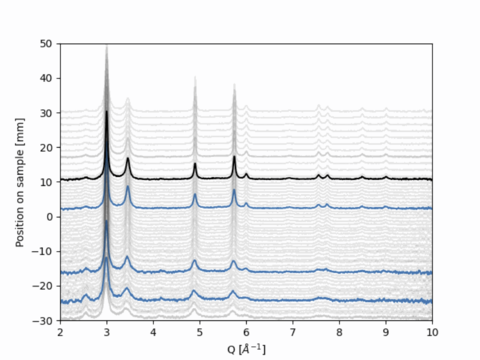AI-Based Materials Characterization Techniques and Analysis

A significant portion of our work is focused on developing and applying AI-based algorithms, data-driven methodologies, and autonomous workflows to a wide range of materials characterization techniques. We have a large number of projects centered around X-ray and neutron scattering-based characterization, microscopy, and image analysis. This work strongly supports the core expertise of the Materials Measurement Science Division and focus areas including semiconductors, industrial gas separation and purification, and ceramic additive manufacturing. In addition to advancing NIST priorities, our efforts are delivering powerful new methods and metrologies to industry stakeholders in the U.S.
X-Ray and Neutron Scattering
X-ray and neutron scattering techniques are powerful tools for studying the atomic structure and magnetic ordering in materials. Yet in many cases, the analysis of scattering data is a manual process. Work in this program develops physics-based AI algorithms to improve the robustness, efficiency, and reproducibility of the analysis.
In some scattering techniques (such as neutron spin wave echo or extended x-ray absorption fine structure spectroscopy) the measurements are slow, requiring long counting times to collect the signal. In this case it can be intractable to exhaustively measure the entire search space. In other techniques (such as High-speed XRD) the bottleneck to the knowledge generation from these measurements is the analysis. Both of these cases can be addressed by replacing the manual analysis with an algorithmic data pipeline.
Microscopy and Image Analysis
Images and collected data from microscopy are vital methods for studying the structure, properties, processing, and performance of materials. Currently, most analysis of this data is done by experts on specific materials. With the evolution of the application of AI algorithms and their applications to images and image-like data, these techniques can improve the analysis of this data.
Microscopic analysis produces data from 1- to 4-dimensions, which range from spectra data (for compositional analysis) to stacks of diffraction patterns (to determine the phase of a material across a volume). Each of these data types requires a different analysis technique, based on the purpose of data collection. For example, a secondary electron image could be used to study a fracture surface or analyze the microstructure of a material. AI algorithms could support the analysis of all types of data on all types of materials and expedite findings.
Projects
- Latest
- User Facilities
- Brookhaven National Laboratory:
- Cornell High Energy Synchrotron Source (CHESS): Autonomous mapping of the crystal structure of materials in a composition spread combinatorial wafers using synchrotron x-ray diffraction at CHESS.
- Autonomous Phase Mapping
- CAMEO (Closed-Loop Autonomous System for Exploration and Optimization): Autonomously and simultaneously maps both the structure and properties of materials in combinatorial wafers using x-ray diffraction in conjunction with property measurement devices. Papers:
- Nature Communications: On-the-fly closed-loop materials discovery via Bayesian active learning
- Frontiers: Physics in the Machine: Integrating Physical Knowledge in Autonomous Phase-Mapping
- Book Chapter: Live Autonomous Beamline Experiments: Physics In the Loop
- Matter: Autonomous experimentation systems for materials development: A community perspective
- Digital Discovery: Learning material synthesis–process–structure–property relationship by data fusion: Bayesian co-regionalization N-dimensional piecewise function learning
- Matter: Scalable multi-agent lab framework for lab optimization
- CAMEO (Closed-Loop Autonomous System for Exploration and Optimization): Autonomously and simultaneously maps both the structure and properties of materials in combinatorial wafers using x-ray diffraction in conjunction with property measurement devices. Papers:
- Optimizing Knowledge Generation
- Autonomous Neutron Diffraction Explorer (ANDiE): Autonomously chooses which neutron powder diffraction measurements in 2θ-space and temperature-space to discover the magnetic ordering in materials.
- Interpreting Large Datasets
- Bayesian Rietveld Refinement - Bayesian inference of correlated sets of powder x-ray diffraction spectra to determine and refine the structures of the materials in the sets.
- HIgh-speed XRD - High-speed algorithmic analysis of high-speed x-ray diffraction measurements of phase transitions and thin films.

